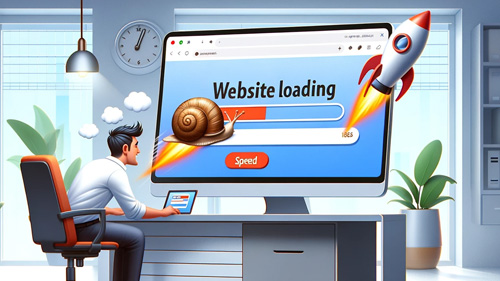Quick Load Times: Your Strategy for Traffic Growth
Wednesday, October 30th, 2024

Could faster loading times be the secret ingredient to maintaining robust website traffic? As digital consumers, our tolerance for waiting has diminished dramatically, making speed a critical factor in website design. A snappy website keeps users engaged and reduces the risk of them bouncing to a competitor due to impatience. This article will peel back the layers on why quick loading times are not just a technical necessity but a crucial element of your digital strategy, ensuring that every second counts towards keeping your visitors satisfied and engaged.
First Impressions Matter: Speed Sets the Tone
Why Speed is Your First Impression
Does your website greet users with a snail-paced load, or does it zip open with zest? Remember, your website’s loading speed is often your audience’s first encounter with your brand, setting the tone for their entire experience. A slow start can be a major turn-off, resulting in a high bounce rate as visitors lose patience and leave. Fast loading ensures a smooth, welcoming introduction to your site, keeping engagement high and frustration low. It’s like opening the door with a friendly smile instead of a long wait in the rain. Moreover, speed instills a perception of efficiency and reliability, traits valued by users who may judge the quality of your content by how quickly they can access it. Websites that load in two seconds or less typically see a bounce rate of just 9%, compared to a staggering 38% for those taking five seconds or more. This dramatic difference highlights the critical nature of speed in digital user experience.
Crafting Seamless User Journeys
Enhancing User Experience Through Speed
How does speed influence the journey a visitor takes on your website? Quick load times are not just about keeping people from leaving; they are about ensuring the journey throughout your site is seamless and enjoyable. A fast-loading page acts like a smooth pathway that leads visitors effortlessly from one section to another, increasing the likelihood of them engaging with more content, making purchases, or signing up for services. Enhanced user experience leads to higher conversion rates and builds a strong foundation for customer loyalty. Fast websites also cater to the increasing number of mobile users who expect quick access on-the-go. This optimization is crucial as mobile traffic grows, ensuring that your site performs well across all devices. Additionally, a swift website reflects positively on your brand, suggesting that you value your visitors’ time and are committed to delivering top-notch service.
SEO: Speed is a Ranking Powerhouse
Boosting Your SEO with Faster Loading Times
Did you know that speed could elevate your website’s position in search rankings? Google has explicitly mentioned site speed as a ranking factor, which means faster sites are more likely to appear higher in search results. This preference is rooted in providing a better user experience, something search engines prioritize. Improving your site’s speed can dramatically increase its visibility, drawing in organic traffic that might otherwise be costly to obtain through paid ads. Techniques like optimizing images, leveraging browser caching, and reducing server response times can have substantial effects. Furthermore, faster sites tend to engage users longer, potentially increasing page views per session, which further signals to search engines that your site offers valuable content. As mobile-first indexing becomes the norm, ensuring your site is quick on smartphones is even more crucial for maintaining strong SEO.
Data-Driven Decisions Enhance Site Performance
Quantifying the Impact of Speed on Traffic
How can you ensure that speed enhancements are actually improving your website? The key lies in data-driven decision-making. By closely monitoring how changes in speed affect your website’s analytics, you can see which modifications make the most significant impact. Tools like Google’s PageSpeed Insights not only analyze your site’s loading times but also provide actionable recommendations to improve them. This continuous feedback loop allows for ongoing optimization, ensuring your site remains fast and functional. Watching how these changes affect user behavior, such as decreased bounce rates or increased time on site, can help you fine-tune your strategies for optimal performance. Remember, each second reduced from loading time could significantly increase user satisfaction and engagement, proving that in the digital world, time really is money.

Technical Mastery for Peak Performance
Technical Optimization: Making Your Site Swift
What technical strategies can you employ to shave seconds off your loading time? Efficiently coding your website, optimizing image sizes, and reducing the number of plugins can dramatically increase speed. These technical tweaks might seem small, but they can collectively shave seconds off your load time, making a substantial difference in user experience. Advanced techniques like implementing Content Delivery Networks (CDNs) distribute your content globally, ensuring faster access regardless of a user’s location. Additionally, minifying CSS, JavaScript, and HTML files by removing unnecessary characters from your code can also speed things up. Adopting these strategies requires a blend of technical know-how and strategic thinking but results in a sleeker, faster-loading site.
Unlock your growth potential: harness specialized free website traffic for niche markets.
Content and Speed: Striking the Right Balance
Balancing High-Quality Content with Fast Load Times

How do you keep your website both rich in content and quick to load? It’s all about finding the right balance. High-quality content is essential for engaging visitors, but it needs to be optimized to prevent slow loading times. Techniques like adaptive image sizing, where images adjust based on the user’s device, ensure fast loading without compromising quality. Moreover, properly formatting videos and choosing the right hosting solutions can prevent these media-rich contents from bogging down your site’s performance. Employing lazy loading, where content loads only as needed, can also improve speed without sacrificing the depth of content. By strategically managing your resources, you can ensure your website remains both engaging and efficient.
As you continue to nurture and develop your digital presence, think of your website like a beloved garden. Just as a garden thrives with regular care and the right conditions, so does your website with consistent optimization and updates. By focusing on speed, you ensure that each visitor can fully enjoy the fruits of your labor, encouraging growth and promoting a vibrant, lively online presence. So, take these steps, plant these seeds of knowledge, and watch your digital garden flourish with increased traffic and happy visitors.
Filed under: Tips & Tricks
Exclusive Offer!
1,500,000 Points for $110 $68. If you're running low on points — don't miss out
limited time